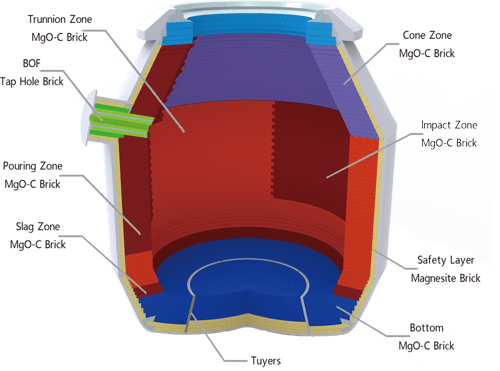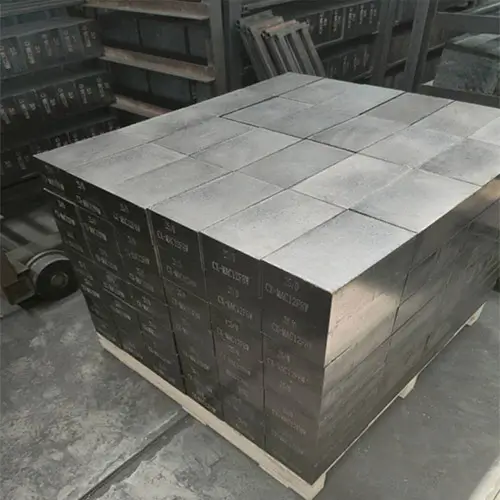Converter is a kind of commonly used steelmaking furnace. Generally can be tilted cylindrical oxygen blowing steelmaking vessel. Furnace body is cylindrical, set on a horizontal axis frame, can be rotated, used for steelmaking. As the working conditions of the various parts of the converter vary greatly, this results in different damage to the individual furnace lining. Therefore, magnesium-carbon bricks with good high-temperature resistance, strong slag resistance, good thermal shock resistance, low high-temperature creep and other advantages of the converter and a good match. Converter parts used to the most refractory bricks is magnesium carbon bricks, we will take a look at the converter of the furnace lining which parts need to use magnesium carbon bricks.
Furnace openings and caps
The refractory bricks used in this part are required to have high thermal shock resistance and slag resistance, which can effectively resist the scouring from the high temperature furnace gas and the spattering of the furnace hold. Therefore, the main use of high-temperature resistant and high strength magnesium carbon bricks.
Charge side of the furnace lining
The charging side of the converter requires the masonry refractory bricks to have high high-temperature strength, good thermal shock resistance, and should have high slag resistance. Therefore, magnesium carbon bricks with high erosion and thermal shock resistance are mostly used in this area.
Both sides of the trunnion area
In addition to the erosion of molten steel and slag in the process of blowing, but also by the scouring and oxygenation of the gas flow, its surface is not covered by the slag layer, so the carbon in the lining brick is very easy to be oxidised, in addition to the damage is not very good repair, erosion is serious, the masonry should be used in the high oxidation resistance and high content of magnesium carbon bricks with a high content of carbon.

Slag line part
Since this area has been in contact with the slag for a long time, it is a serious part of the erosion by the slag. Coupled with the blowing process of the converter belly suffered other roles, so this part of the erosion degree is more serious. Therefore, high erosion resistance refractory bricks should be used.
Melting pool section
In the blowing process, although by the steel erosion effect, but compared with other parts of the damage is lighter, and converter sputtering slag furnace guarding operation tends to make the bottom of the converter furnace rises, so the converter melting pool part of the ordinary magnesium-carbon bricks can be used.
Furnace cylinders and bottoms
These parts in the blowing by the violent scouring of steel, but compared with other parts of the damage rate is low, can choose low carbon content of magnesium-carbon bricks.
Taphole Outlet section
Steel outlet by high temperature steel and slag erosion and scouring, as well as the impact of rapid changes in temperature, damage is more serious, so should be masonry with good erosion resistance, high oxidation resistance of magnesium carbon brick, generally using the whole magnesium carbon bricks, or a combination of magnesium carbon bricks, and the use of a certain number of times will need to be repaired or replaced.

More details about magnesium carbon bricks
What are mag carbon bricks used for?
MgO-C (magnesia-carbon) refractory bricks are widely used in steel industry, the primary consumer of refractory linings, such as basic oxygen furnaces, electric arc furnaces, and ladle furnaces.
What are the properties of MgO-C bricks?
MgO-C bricks are composed of magnesia clinker, flake graphite, antioxidants, resin components, etc., and have high resistance to corrosion, spalling, and slag penetration thanks to the characteristics of their constituents.
What is the temperature of magnesia carbon bricks?
Magnesia carbon brick is with high melting point alkali oxide magnesium melting point (2800 degrees Celsius) and difficult to be slag infiltration of high melting point carbon material as raw material, add a variety of non oxide additives.
